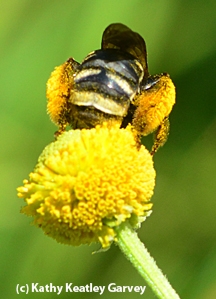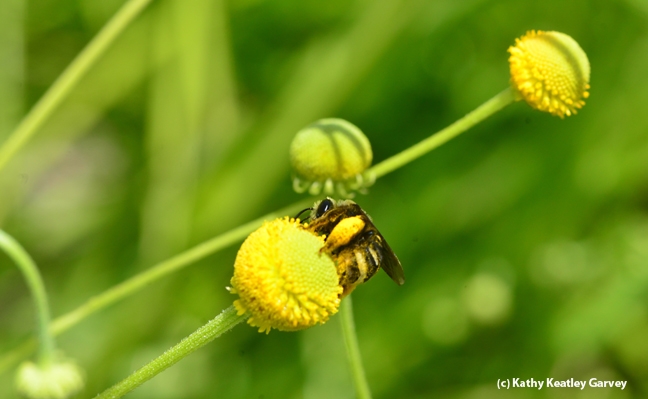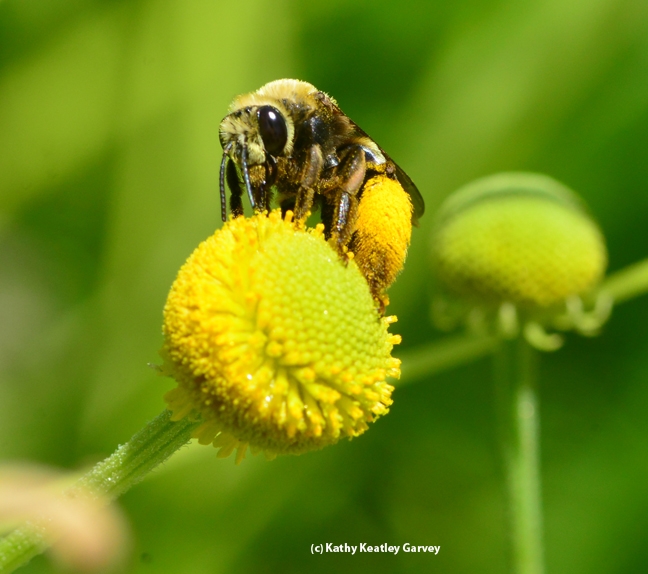
Over at the UC Davis Arboretum GATEway Garden. off First Street in downtown Davis, sneezeweed is blooming and bees and butterflies are all over it.
We didn't see any of them "sneezing." :)
A female long-horned bee, Svastra obliqua expurgata (as identified by native pollinator expert Robbin Thorp, distinguished emeritus professor of entomology at UC Davis, zipped from one blossom to another.
"It's a bee that prefers sunflower but will collect pollen from a variety of members of the Aster family," Thorp commented.
He's the co-author of the newly published book, California Bees and Blooms: A Guide for Gardeners and Naturalists (along with UC-affiliated colleagues Gordon Frankie, Rollin E. Coville and Barbara Ertter), a must for everyone who wants to learn about bees and blooms.
The GATE in GATEway Project means Gardens, Arts, and The Environment. It's a portal into the UC Davis Arboretum, a welcome retreat, an enjoyable walking jogging and bicycling site, and an educational experience for UC Davis faculty, staff, students and visitors. Be sure to check out the other GATEways in the Arboretum, including the Animal Science GATEway Garden, the Geology GATEway Garden, and the Nature's Gallery Court.
And the sneezeweed? A wonderful choice. It's eye-catching to visitors and pollen-beckoning to pollinators. (And just in time for National Pollinator Week, June 15-21. It's sponsored by the National Pollinator Partnership.)
The U.S. Department of Agriculture's Forest Service devotes a page to the sneezeweed. "Its abundant yellow blooms can be found in late summer to fall, often attracting bees and butterflies. Common sneezeweed can be found in much of the United States, in moist to wet openings, edges, shores, and thickets."
"Like other members of the aster family, the 1-2 inch sneezeweed flower is composite—with large, showy ray flowers that look like petals, and smaller disk flowers making up the center," writes Sue Trull, Ottawa National Forest. She points out that thebright yellow "petals" are wedge-shaped, with three lobes on the outer end, drooping away from the central disk. The center is nearly spherical, projecting above the skirt-like whorl of petals. The center disk flowers are a duller yellow color than the petals. The plant's stem branches near the top, resulting in many flowers on each plant."
"Sneezeweed leaves are lance-shaped to narrowly oval, with a few teeth. These leaves occur alternately on the stem. They are directly attached, with the leaf base continuing down the stem as a wing. Sneezeweed stems can be slightly hairy and they can reach five feet or more in height."
If you don't want to call the yellow flower a sneezeweed, you can call it by its other common names, including Helen's flower, bitterweed, autumn sneezeweed and false sunflower.
Trull says the genus name, Helenium, "refers to the famous Helen of Troy. There is a legend that these flowers sprang from the ground where Helen's tears fell. The species name, autumnale, refers to the season of the flower's blooming—autumn. Synonyms for the scientific name include Helenium canaliculatum, H. latifolium, and H. parviflorum."
How did it get its name, sneezeweed? "According to a 1923 publication by H. Smith of the Milwaukee Public Museum, the name given to the plant by the Menominee Indians of the Wisconsin area is 'aiatci'a ni'tcîkûn,' which means "sneezing spasmodically," Trull says.
"With its large showy flowers, insects pollinate common sneezeweed, not wind," Trull writes. "Therefore, it does not have small pollen grains, like ragweed does, which cause sneezing and other hay fever symptoms. This is not the reason for the Menominee and English names for the plant. The common name is based on historic use of the crushed dried leaves and heads to make a form of snuff that caused sneezing. In certain cultures and times, sneezing was regarded as a desirable way to rid the body of evil spirits or a way to loosen up a head cold, so that a sneeze-producing remedy was desirable. Having crushed dried sneezeweed heads to collect the seeds, the author can attest to the plant's sneeze-producing power!"
But you don't want to eat the leaves, flowers or seeds. They're poisonous if eaten in large quantities, Trull says. They cause gastric and intestinal irritation to us human beings--"which can become fatal."
You also don't want livestock, especially sheep, or Fido around them.
The poisonous substance this plant produces serves to protect the plant from pathogens and herbivores--but not from pollinators!
Attached Images:

